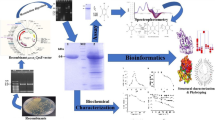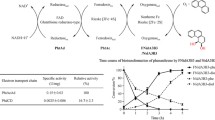Abstract
Comamonas testosteroni T-2 degraded at least eight aromatic compounds via protocatechuate (PCA), whose extradiol ring cleavage to 2-hydroxy-4-carboxymuconate semialdehyde (HCMS) was catalysed by PCA 4,5-dioxygenase (PmdAB). This inducible, heteromultimeric enzyme was purified. It contained two subunits, α (PmdA) and β (PmdB), and the molecular masses of the denatured proteins were 18 kDa and 31 kDa, respectively. PCA was converted stoichiometrically to HCMS with an apparent Km of 55 μM and at a maximum velocity of 1.5 μkat. Structure–activity-relationship analysis by testing 16 related compounds as substrate for purified PmdAB revealed an absolute requirement for the vicinal diol and for the carboxylate group of PCA. Besides PCA, only 5′-hydroxy-PCA (gallate) induced oxygen uptake. The N-terminal amino acid sequence of each subunit was identical to the corresponding sequences in C. testosteroni BR6020, which facilitated sequencing of the pmdAB genes in strain T-2. Small differences in the amino acid sequence had significant effects on enzyme stability. Several homologues of pmdAB were found in sequence databases. Residues involved in substrate binding are highly conserved among the homologues. Their sequences grouped within the class III extradiol dioxygenases. Based on our biochemical and genetic analyses, we propose a new branch of the heteromultimeric enzymes within that class.





Similar content being viewed by others
References
Altschul SF, Madden TL, Schäffer AA, Zhang J, Zhang Z, Miller W, Lipman DJ (1997) Gapped BLAST and PSI-BLAST: a new generation of protein database search programs. Nucleic Acids Res 25:3389–3402
Arciero DM, Lipscomb JD (1986) Binding of 17O-labeled substrate and inhibitors to protocatechuate 4,5-dioxygenase-nitrosyl complex. J Biol Chem 261:2170–2178
Arciero DM, Lipscomb JD, Huynh BH, Kent TA, Münck E (1983) EPR and Mössbauer studies of protocatechuate 4,5-dioxygenase. Characterization of a new Fe2+ environment. J Biol Chem 258:14981–14991
Bradford M (1976) A rapid and sensitive method for the quantitation of microgram quantities of protein utilizing the principle of protein-dye binding. Anal Biochem 72:248–254
Busse H-J, El-Banna T, Oyaizu H, Auling G (1992) Identification of xenobiotic-degrading isolates from the beta subclass of the Proteobacteria by a polyphasic approach including 16S rRNA partial sequencing. Int J Syst Bacteriol 42:19–26
Contzen M, Bürger S, Stolz A (2001) Cloning of the genes for a 4-sulphocatechol-oxidizing protocatechuate 3,4-dioxygenase from Hydrogenophaga intermedia S1 and identification of the amino acid residues responsible for the ability to convert 4-sulphocatechol. Mol Microbiol 41:199–205
Cook AM (1987) Biodegradation of s-triazine xenobiotics. FEMS Microbiol Rev 46:93–116
Cook AM, Laue H, Junker F (1999) Microbial desulfonation. FEMS Microbiol Rev 22:399–419
Dagley S, Evans WC, Ribbons DW (1960) New pathways in the oxidative metabolism of aromatic compounds by micro-organisms. Nature (Lond) 188:560–566
Dagley S, Geary PJ, Wood JM (1968) The metabolism of protocatechuate by Pseudomonas testosteroni. Biochem J 109:559–568
Eaton RW (2001) Plasmid-encoded phthaltate catabolic pathway in Arthrobacter keyseri 12B. J Bacteriol 183:3689–3703
Eltis LD, Bolin JT (1996) Evolutionary relationships among extradiol dioxygenases. J Bacteriol 178:5930–5937
Fersht AR (1999) Structure and mechanism in protein science. Freeman, New York
Hara H, Masai E, Miyauchi K, Katayama Y, Fukuda M (2003) Characterization of the 4-carboxy-4-hydroxy-2-oxoadipate aldolase gene and operon structure of the protocatechuate 4,5-cleavage pathway genes in Sphingomonas paucimobilis SYK-6. J Bacteriol 185:41–50
Harayama S, Rekik M (1989) Bacterial aromatic ring-cleavage enzymes are classified in two different gene families. J Biol Chem 264:15328–15333
Harayama S, Rekik M (1993) Comparison of the nucleotide sequences of the meta-cleavage pathway genes of TOL plasmid pWW0 from Pseudomonas putida with other meta-cleavage genes suggests that both single and multiple nucleotide substitutions contribute to enzyme evolution. Mol Gen Genet 239:81–89
Harayama S, Kok M, Neidle EL (1992) Functional and evolutionary relationships among diverse oxygenases. Annu Rev Microbiol 46:565–601
Hirose J, Kimura N, Suyama A, Kobayashi A, Hayashida S, Furukawa K (1994) Functional and structural relationship of various extradiol aromatic ring-cleavage dioxygenases of Pseudomonas origin. FEMS Microbiol Lett 118:273–277
Jeanmougin F, Thompson JD, Gouy M, Higgins DG, Gibson TJ (1998) Multiple sequence alignment with Clustal X. Trends Biochem Sci 23:403–405
Junker F, Field JA, Bangerter F, Ramsteiner K, Kohler H-P, Joannou CL, Mason JR, Leisinger T, Cook AM (1994a) Oxygenation and spontaneous deamination of 2-aminobenzenesulphonic acid in Alcaligenes sp. strain O-1 with subsequent meta ring cleavage and spontaneous desulphonation to 2-hydroxymuconic acid. Biochem J 300:429–436
Junker F, Leisinger T, Cook AM (1994b) 3-Sulphocatechol 2,3-dioxygenase and other dioxygenases (EC 1.13.11.2 and EC 1.14.12.-) in the degradative pathways of 2-aminobenzenesulphonic, benzenesulphonic and 4-toluenesulphonic acids in Alcaligenes sp. strain O-1. Microbiology 140:1713–1722
Junker F, Saller E, Schläfli Oppenberg HR, Kroneck PMH, Leisinger T, Cook AM (1996) Degradative pathways for p-toluenecarboxylate and p-toluenesulfonate and their multi-component oxygenases in Comamonas testosteroni strains PSB-4 and T-2. Microbiology 142:2419–2427
Kennedy SIT, Fewson CA (1968) Enzymes of the mandelate pathway in bacterium N.C.I.B. 8250. Biochem J 107:497–506
Kersten PJ, Chapman PJ, Dagley S (1985) Enzymatic release of halogens or methanol from some substituted protocatechuic acids. J Bacteriol 162:693–697
Larimer FW, et al (2004) Complete genome sequence of the metabolically versatile photosynthetic bacterium Rhodopseudomonas palustris. Nat Biotechnol 22:55–61
Laue H, Cook AM (2000) Purification, properties and primary structure of alanine dehydrogenase involved in taurine metabolism in the anaerobe Bilophila wadsworthia. Arch Microbiol 174:162–167
Laue H, Field JA, Cook AM (1996) Bacterial desulfonation of the ethanesulfonate metabolite of the chloroacetanilide herbicide metazachlor. Environ Sci Technol 30:1129–1132
Laue H, Friedrich M, Ruff J, Cook AM (2001) Dissimilatory sulfite reductase (desulfoviridin) of the taurine- degrading, non-sulfate-reducing bacterium Bilophila wadsworthia RZATAU contains a fused DsrB-DsrD subunit. J Bacteriol 183:1727–1733
Locher HH, Leisinger T, Cook AM (1989) Degradation of p-toluenesulphonic acid via sidechain oxidation, desulphonation and meta ring cleavage in Pseudomonas (Comamonas) testosteroni T-2. J Gen Microbiol 135:1969–1978
Locher HH, Leisinger T, Cook AM (1991) 4-Sulphobenzoate 3,4-dioxygenase: purification and properties of a desulphonative two-component enzyme system from Comamonas testosteroni T-2. Biochem J 274:833–842
Mampel J (2000) Transport und Regulationsphänomene beim Abbau von 4-Toluolsulfonat in Comamonas testosteroni. PhD Thesis, Department of Biology, University of Konstanz
Mampel J, Maier E, Tralau T, Ruff J, Benz R, Cook AM (2004) A novel outer-membrane anion channel (porin) as part of a putatively two-component transport system for 4-toluenesulphonate in Comamonas testosteroni T-2. Biochem J 383:91–99
Maruyama K, Shibayama T, Ichikawa A, Sakou Y, Yamada S, Sugisaki H (2004) Cloning and characterization of the genes encoding enzymes for the protocatechuate meta-degradation pathway of Pseudomonas ochraceae NGJ1. Biosci Biotechnol Biochem 68:1434–1441
Nakatsu CH, Straus NA, Wyndham RC (1995) The nucleotide sequence of the Tn 5271 3-chlorobenzoate 3,4-dioxygenase genes (cbaAB) unites the class IA oxygenases in a single lineage. Microbiology 141:485–495
Neuhoff V, Arold N, Taube D, Ehrhardt W (1988) Improved staining of proteins in polyacrylamide gels including isoelectric focusing gels with clear background at nanogram sensitivity using Coomassie Brilliant Blue G-250 and R-250. Electrophoresis 9:255–262
Noda Y, Nishikawa S, Shiozuka K, Kadokura H, Nakajima H (1990) Molecular cloning of the protocatechuate 4,5-dioxygenase genes of Pseudomonas paucimobilis. J Bacteriol 172:2704–2709
Peng X et al. (1998) Cloning of a Sphingomonas paucimobilis SYK-6 gene encoding a novel oxygenase that cleaves lignin-related biphenyl and characterization of the enzyme. Appl Environ Microbiol 64:2520–2527
Providenti MA, Mampel J, MacSween S, Cook AM, Wyndham RC (2001) Comamonas testosteroni BR6020 possesses a single genetic locus for extradiol cleavage of protocatechuate. Microbiology 147:2157–2167
Ribbons DW, Evans DC (1960) Oxidative metabolism of phthalic acid by soil pseudomonads. Biochem J 76:310–318
Saccone C, Lanave C, Pesole G, Preparata G (1990) Influence of base composition on quantitative estimates of gene evolution. Methods Enzymol 183:570–583
Saccone C, Lanave C, Pesole G (1993) Time and biosequences. Int J Syst Evol Microbiol 37:154–159
Sato S-I, Ouchiyama N, Kimura T, Nojiri H, Yamane H, Omori T (1997) Cloning of genes involved in carbazole degradation of Pseudomonas sp. strain CA10: nucleotide sequences of genes and characterization of meta-cleavage enzymes and hydrolase. J Bacteriol 179:4841–4849
Schägger H, von Jagow G (1987) Tricine-sodium dodecyl sulfate-polyacrylamide gel electrophoresis for the separation of proteins in the range from 1 to 100 kDa. Anal Biochem 166:368–379
Schläfli Oppenberg HR, Chen G, Leisinger T, Cook AM (1995) Regulation of the degradative pathways from 4-toluenesulphonate and 4-toluenecarboxylate to protocatechuate in Comamonas testosteroni T-2. Microbiology 141:1891–1899
Spence EL, Kawamukai M, Sanvoisin J, Braven H, Bugg TDH (1996) Catechol dioxygenases from Escherichia coli (MhpB) and Alcaligenes eutrophus (MpcI): sequence analysis and biochemical properties of a third family of extradiol dioxygenases. J Bacteriol 178:5249–5256
Sugimoto K, Senda T, Aoshima H, Masai E, Fukuda M, Mitsui Y (1999) Crystal structure of an aromatic ring opening dioxygenase LigAB, a protocatechuate 4,5-dioxygenase, under aerobic conditions. Structure (Lond) 7:953–965
Thurnheer T, Köhler T, Cook AM, Leisinger T (1986) Orthanilic acid and analogues as carbon sources for bacteria: growth physiology and enzymic desulphonation. J Gen Microbiol 132:1215–1220
Tralau T, Cook AM, Ruff J (2001) Map of the IncP1b plasmid pTSA encoding the widespread genes (tsa) for p-toluenesulfonate degradation in Comamonas testosteroni T-2. Appl Environ Microbiol 67:1508–1516
Tralau T, Cook AM, Ruff J (2003a) An additional regulator, TsaQ, is involved with TsaR in regulation of transport during the degradation of p-toluenesulfonate in Comamonas testosteroni T-2. Arch Microbiol 180:319–326
Tralau T, Mampel J, Cook AM, Ruff J (2003b) Characterization of TsaR, an oxygen-sensitive LysR-type regulator for the degradation of p-toluenesulfonate in Comamonas testosteroni T-2. Appl Environ Microbiol 69:2298–2305
Vuilleumier S, Ivos N, Dean M, Leisinger T (2001) Sequence variation in dichloromethane dehalogenases/glutathione S-transferases. Microbiology 147:611–619
Wattiau P, Bastiaens L, van Herwijnen R, Daal L, Parsons JR, Renard ME, Springael D, Cornelis GR (2001) Fluorene degradation by Sphingomonas sp. LB126 proceeds through protocatechuic acid: a genetic analysis. Res Microbiol 152:861–872
Yun SH, Yun CY, Kim SI (2004) Characterization of protocatechuate 4,5-dioxygenase induced from p-hydroxybenzoate-cultured Pseudomonas sp. K82. J Microbiol 42:152–155
Zabinski R, Münck E, Champion PM, Wood JM (1972) Kinetic and Mossbauer studies on the mechanism of protocatechuic acid 4,5-oxygenase. Biochemistry 11:3212–3219
Acknowledgements
We are grateful to T. Tralau, who kindly did the Markov analyses, and to D. Schleheck, who did the lutidinic acid experiment. J.M. was funded by the Deutsche Forschungsgemeinschaft (to A.M.C. and J. Ruff) and BASF/BMBF, and M.A.P. by the Alexander von Humboldt Stiftung. Further funds were from the University of Konstanz and the Fonds der Chemischen Industrie.
Author information
Authors and Affiliations
Corresponding author
Rights and permissions
About this article
Cite this article
Mampel, J., Providenti, M.A. & Cook, A.M. Protocatechuate 4,5-dioxygenase from Comamonas testosteroni T-2: biochemical and molecular properties of a new subgroup within class III of extradiol dioxygenases. Arch Microbiol 183, 130–139 (2005). https://doi.org/10.1007/s00203-004-0755-4
Received:
Revised:
Accepted:
Published:
Issue Date:
DOI: https://doi.org/10.1007/s00203-004-0755-4




